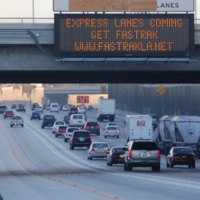L.A.'s Lucrative Lexus Lanes Extended after Study Shows Small Advantage for a Privileged Few
 I-110 Freeway in Los Angeles
I-110 Freeway in Los Angeles
Experimental freeway toll lanes in Los Angeles, known as “Lexus lanes” in some circles, aren't speeding traffic up for very many drivers and are slowing down others, but generating millions of dollars in revenue.
That was good enough for the county's Metropolitan Transportation Authority (MTA) board of directors to declare the one-year pilot program a success last week and give their unanimous blessing to an extension beyond the scheduled January 1, 2015, expiration.
The extension is dependent on lawmakers passing Senate Bill 1298, which removes limitations on the number of high-occupancy toll (HOT) lanes that the California Transportation Commission (CTC) can approve statewide and specifically blesses and enhances the L.A. lanes.
The express lanes on the Harbor (I-110) and Santa Monica (I-10) freeways allow solo drivers who pay a toll using transponders to join carpoolers and motorcyclists to travel more quickly. The county's first attempt at “congestive pricing” charges a higher toll when traffic is heavier. Tolls range from 25 cents a mile and to $1.40 a mile.
Critics of this form of traffic control contend that “Lexus lanes” are mostly just a perk for wealthier people. They decry the trend toward substituting user fees for tax-based government solutions to community issues, and argue that problems won’t be addressed if we allow the more privileged members of society to dodge them.
The independent study cited by the board, conducted for the Federal Highway Administration (FWHA), found very little change for any drivers, free or paying, during peak hours; it all sucked. But for certain drivers at certain times—westbound on the 10 at 7:30 a.m., for instance—they scurried by 18 mph faster on average.
Overall, drivers in the I-10 fast lane during the morning and evening commutes picked up about two minutes. Those in the slow lanes also shaved a couple minutes off their commute in the morning but took four more minutes in the afternoon.
The news wasn't as good on the I-110. Drivers in the toll lane actually lost nearly two minutes in the morning and were a hair slower in the evening. Those in the slow lanes experienced no change in the morning and were one and a half minutes slower in the evening.
While the traffic numbers were nothing special, the HOT revenue numbers generated some heat. The state collected $23 million in 14 months. That kind of revenue can potentially be leveraged by floating bonds against it and could conceivably yield a “debt capacity” of between $72 million and $205 million.
The board also approved a $1 monthly maintenance fee on most drivers with ExpressLane accounts. When the board originally charged a monthly $3 fee, public uproar forced a rollback.
–Ken Broder
To Learn More:
Expresslanes on 10 and 110 Freeways to Be Continued Beyond Next January (by Steve Hymon, Los Angeles County Metropolitan Transportation Authority)
Metro, Legislature May Make Pay Lanes on Two L.A. County Freeways Permanent (by Steve Scauzillo, San Gabriel Valley Tribune)
Motion Passed by MTA Officials to Keep Express Lanes (by Irene Moore and Reggie Kumar, NBC Southern California)
Metro Backs Extension of Freeway Toll Lanes, Adds $1 Monthly Fee (by Laura J. Nelson, Los Angeles Times)
Solo Drivers in L.A. Who Can Afford Carpool Lanes Are Zipping Past Their Slower Brethren (by Ken Broder, AllGov California)
- Top Stories
- Controversies
- Where is the Money Going?
- California and the Nation
- Appointments and Resignations
- Unusual News
- Latest News
- California Forbids U.S. Immigration Agents from Pretending to be Police
- California Lawmakers Urged to Strip “Self-Dealing” Tax Board of Its Duties
- Big Oil’s Grip on California
- Santa Cruz Police See Homeland Security Betrayal in Use of Gang Roundup as Cover for Immigration Raid
- Oil Companies Face Deadline to Stop Polluting California Groundwater





